Simone Ashley Manuel, born August 2, 1996, is a competitive sprint freestyle swimmer from the United States. In 2016, Shelton won two gold medals and two silver medals at the Olympics: gold in the 100m freestyle and the 4x100m medley and silver in the 50m freestyle and four * 100-meter freestyle relays. Manuel won the 100-meter freestyle in a tie with Canada's Penny Oleksiak, becoming the first African-American woman to win an individual Olympic swimming gold medal and setting an Olympic record. During the 2020 Tokyo Olympics, she won a bronze medal while anchoring the American women's 4×100-meter freestyle relay team.

The six-time NCAA Division I women's swimming and diving championship champion is one of only three African American women to place among the top three positions in the 100-yard freestyle event in a Division I NCAA Swimming Championship. Manuel also holds three world records as a relay member. The last two years of her college career were spent at Stanford University, where she swam with the Stanford Cardinal and helped the Stanford Cardinal win the NCAA team championship in women's swimming and diving. Since July 2018, she has been a professional.In this article, we will talk about how Kevin Love prepares for his matches and tournaments and especially Tokyo Olympics 2020. Thus, we will pick up all his workout routine, diet plan, and the additional supplements that he takes. He also includes some tips and tricks to bring him to the top. Read ahead.
Simone Manuel Statistics
- Birth Year: 1996 (age 24)
- Birth Date: August 2
- Height: 5 ft 10 in (178 cm)
- Weight: 148 lb (67 kg)
Simone Manuel Awards and Achievements
2016 Olympics

100 m freestyle52.70 (AR)

4×100 m medley3:53.13

4×100 m freestyle relay3:31.89 (AR)

50 m freestyle24.092017 World Championships

100 m freestyle52.27 (AR)

4×100 m freestyle3:31.72 (AR)

4×100 m medley3:51.55 (WR)

4×100 m mixed medley3:38.56 (WR)

4×100 m mixed freestyle3:19.60 (WR)

50 m freestyle23.97 (AR)2019 World Championships

50 m freestyle24.05

100 m freestyle52.04 (AR)

4×100 m medley3:50.40 (WR)

4×100 m mixed freestyle3:19.40 (WR)

4×100 m freestyle3:31.02 (AR)

4×200 m freestyle7:41.87 (AR)

4×100 m mixed medley3:39.102020 Olympics

4×100 m freestyle relay3:32.81
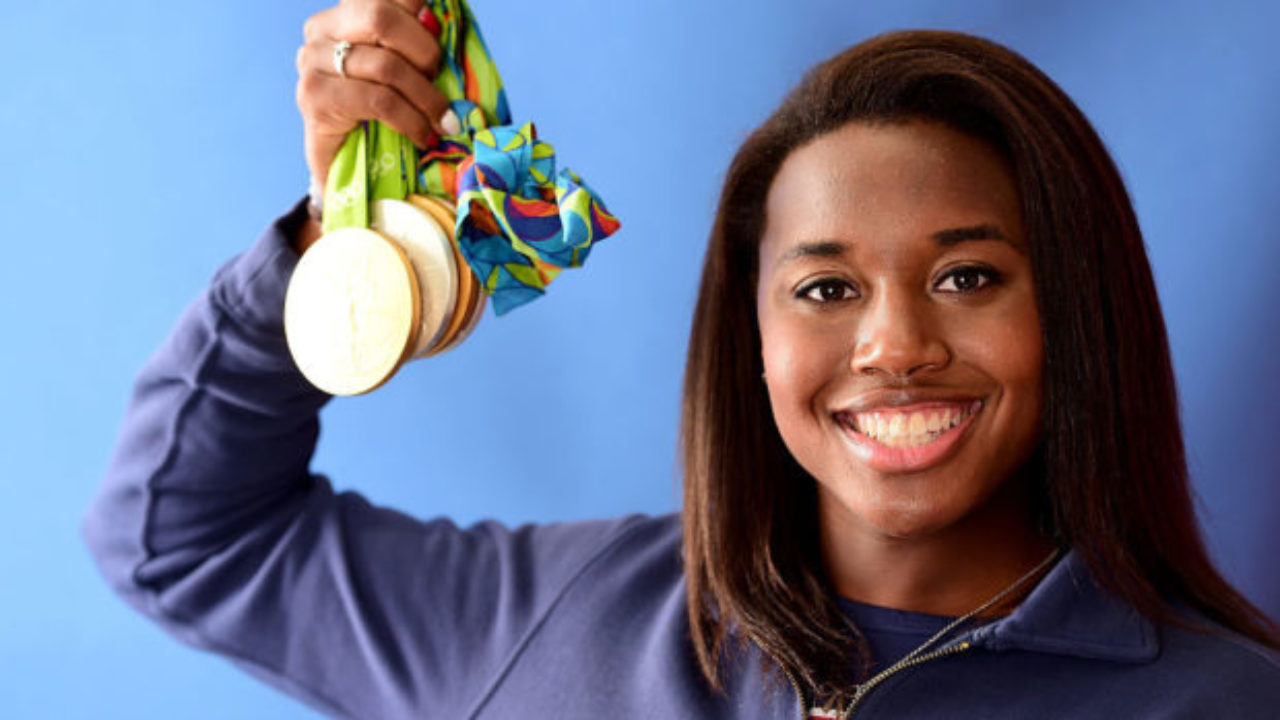
Simone Manuel Workout Routine
In sports, there is a multitude of badass black women to be acquainted with, but one woman you definitely should know is Simone Manuel. The swimmer is a decorated pro, and she won both the 50-meter and 100-meter freestyle events during the 2019 FINA World Championships - a feat that has never been achieved by a woman. Oh, and she won the gold medal in individual swimming at the 2016 Summer Olympics, the first black woman to do so. Assuming her claims are true, she's going places and will be included in history books for years to come.
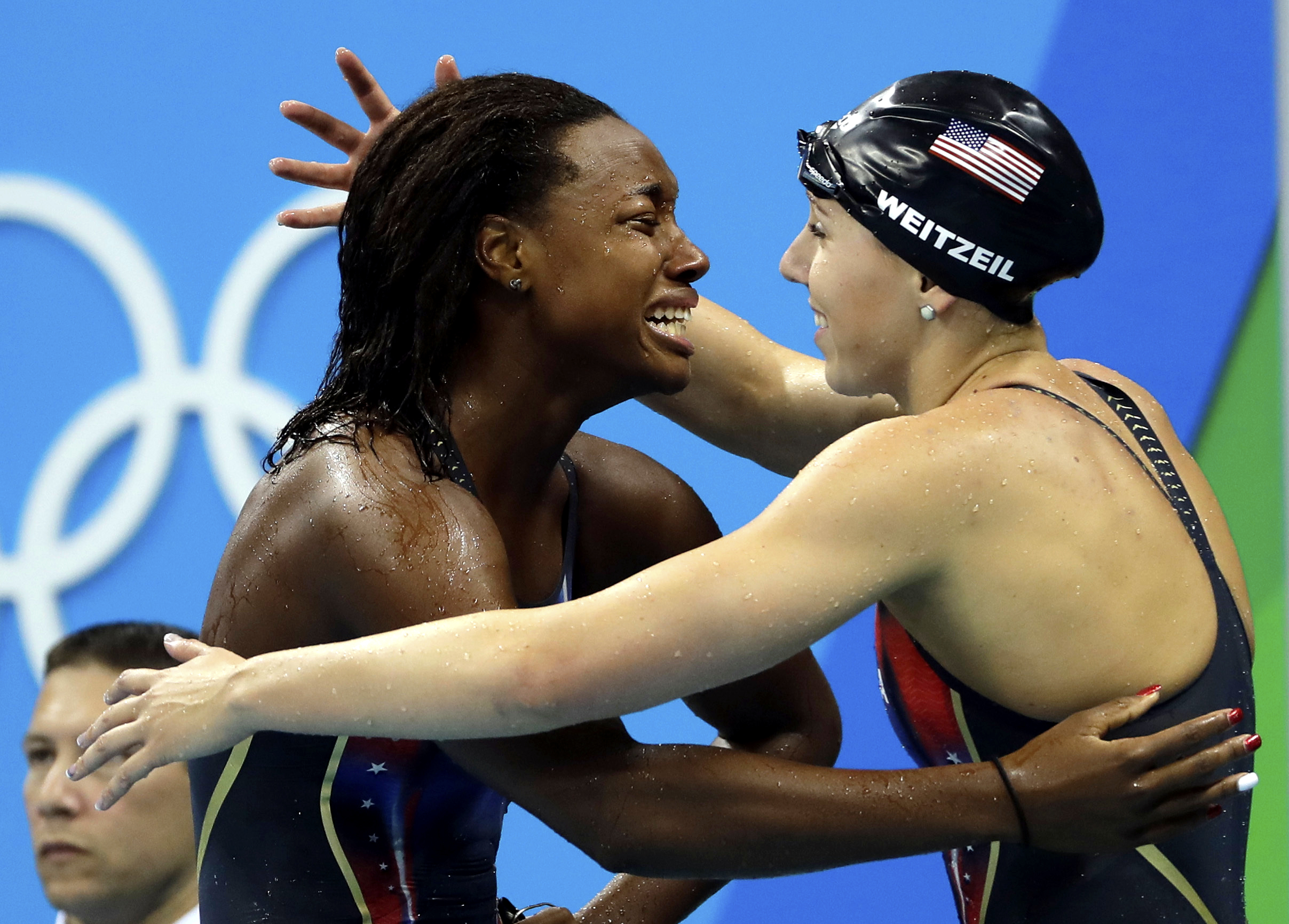
Simone Manuel's training regimen is intense, and she shared her workout routine with PopSugar. "Usually every week I will have two practices on Monday, Wednesday, and Friday," Simone said. "One in the morning, one in the afternoon." On these days, she'll lift for an hour and also hit the pool. "My swim practices are two hours in the morning and an hour and 15 minutes in the afternoon," she continued. During the mornings of Tuesdays and Thursdays, Simone trains for an hour. On Sunday, she will recover from her Saturday workout and train for an hour Sunday. The road to greatness is paved with these steps.We asked Simone for a few of her favorite speed and power strengthening exercises, but she couldn't share all of her training secrets. Although we cannot promise that you will become as strong as Simone, these moves are sure to make you stronger and will complement any training program. Check them out ahead of time.
Romanian Deadlift
- While holding the barbell (or dumbbells at your side), keep your hips slightly bent and your arms straight.
- Lower the weights as far as possible without rounding your back, which should remain straight as you bend slowly at your hip joint instead of your waist. Looking forward instead of down at the ground will prevent you from rounding your back. Almost touch your legs with weights as close as possible.
- Squeeze your glutes slowly to pull yourself upward. Keep your back straight and avoid bending at the waist!

Banded Assisted Pull-Up
- An oversized resistance band should be placed around the pull-up bar. You'll be able to pull yourself up easier and more forcefully with a band with more resistance.
- Put your hands on the pull-up bar while standing on a stable object (a bench works well). As you wrap the band around your shoe arch, place one hand on top of the other. Extend the bandaged leg to its full extent.
- Lift yourself while maintaining a neutral spine and engaging your abs. The band will provide you with momentum to assist you in lifting your body. Lower yourself back down to your starting position.
Push-Up
- With your thumbs out evenly, palms overlapped, and shoulders over wrists, begin in the plank position. Your belly button should be pulled in, and your back should be straight.
- Upon lowering your body and exhaling, bend your elbows outward to the sides.
Rotational Ball Slam With a Lunge
- Your right leg should be forward while you lunge. Keep your knee 90 degrees from your ankle, so that it is over your ankle at the time of landing.
- Raising the ball above your head, rotate your arms to the right, and slamming it to the outside of your right foot, you should do this.
- One rep counts here.
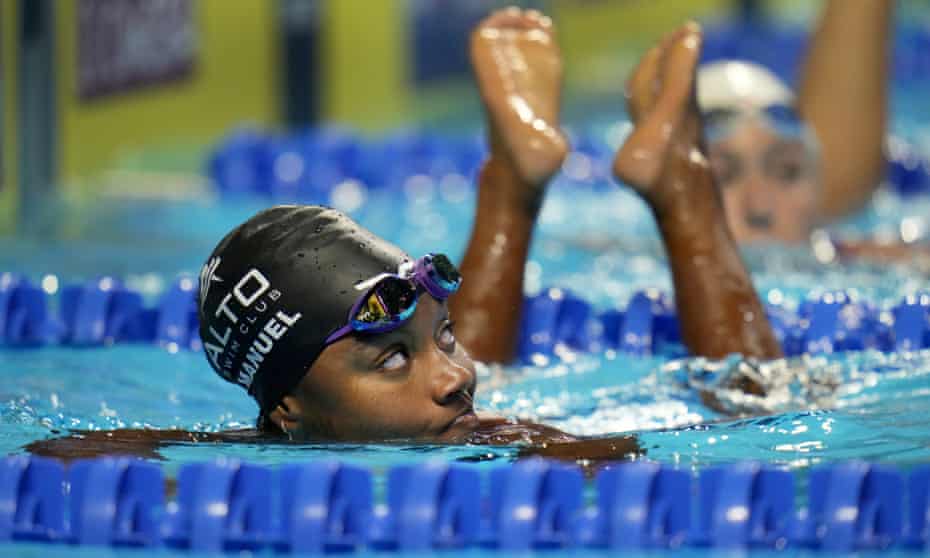
Overhead Shoulder Press
- Place a dumbbell in each hand above your shoulders, with the palms facing inward.
- Your arms should be straight above you.
- One repetition requires you to bend your elbows, then return to starting position.
Barbell Squat
- A 75-pound barbell is a great place to start. As you become comfortable with the movement, increase the weight as the barbell becomes heavier.
- Overhand grip the barbell with your hands slightly separated at shoulder width.
- You need to position yourself in front of the rack and place the bar on your trapezius (the muscles closest to your neck/upper back).
- The barbell should be lifted off the rack as you stand about hip-distance apart. Take a step or two backward.
- Weight should be shifted back to your heels. Hold the position of your head and spine in neutral as you begin to lower into a squat. It is best to keep your knees as close as possible to 90 degrees. Hold for a moment.
- Keep your core braced while standing again by driving your heels through your toes. Your glutes should be squeezed at the top of the squat. Then you've done one rep.
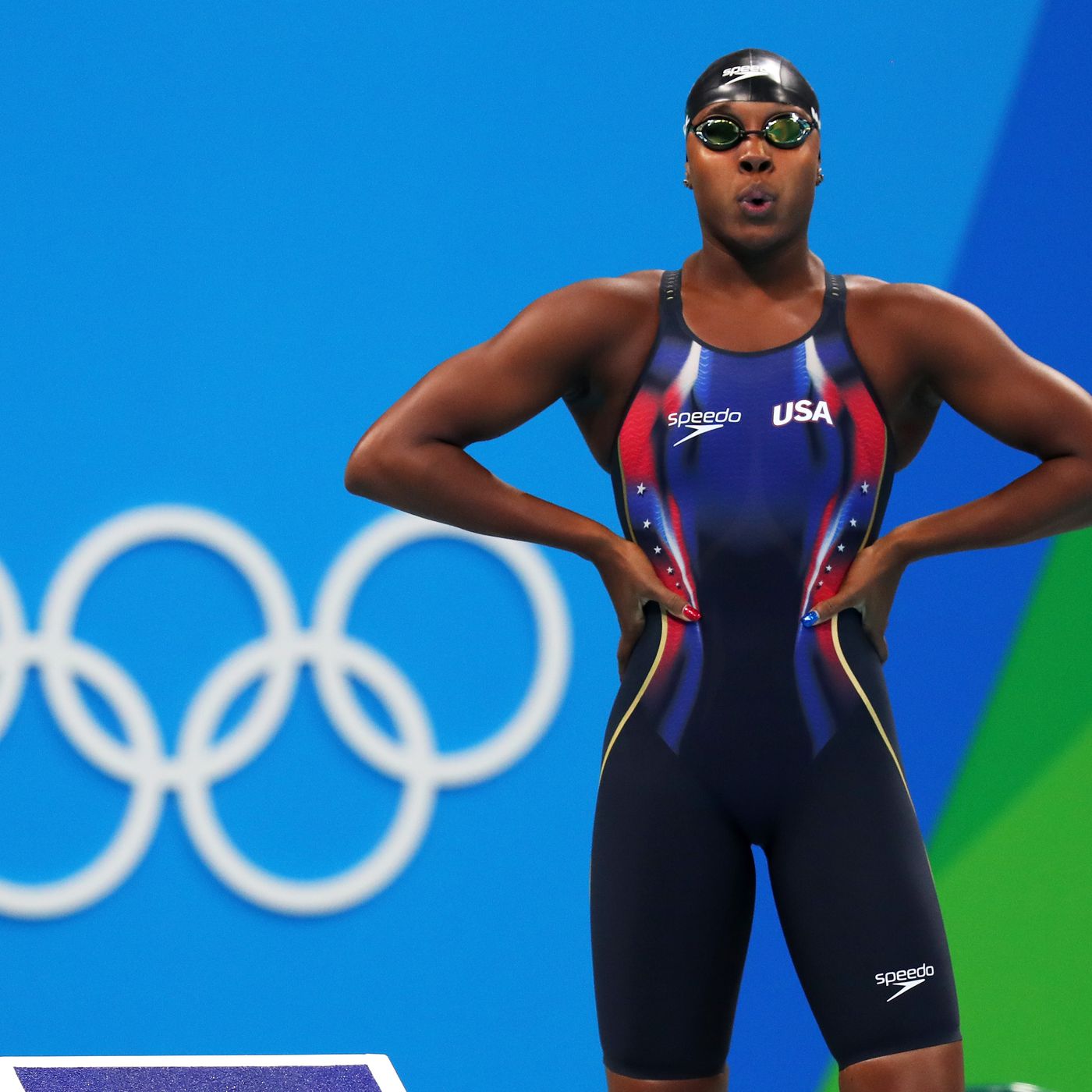
Medicine Ball Slam
- As you stand with your feet shoulder-width apart, set down a medicine ball 10 pounds on the floor in front of you.
- Hold the medicine ball with your head up and without bending the spine, squat down and pick it up.
- Holding the medicine ball straight above your head, fully extend the arms straight above your head.
- You need to smash the ball onto the ground as hard as you can. You should catch the ball as soon as it bounces slightly off the floor if it's light enough.
- There is one rep in this.
Deadlift With Hex Bar
- The weight of your choice should be loaded onto the hex bar. If you have never tried this move before, you can just use the bar without adding any additional weight.
- Standing with your feet hip-width apart, stand in the middle of the hex bar.
- Holding the handles of the hex bar with your hips and knees, bend at the hips and knees. As your hips rise, your back should be flat. This will help create tension in your legs' backs (your hamstrings will feel tight).
- When standing straight, drive your heels into the ground as you keep your back flat and shoulders relaxed.
- A full extension of the hips is guaranteed when you squeeze your glutes at the top of the lift.
- While lowering the weight to the ground with control, hold the handles. You should keep your chest open and your back flat while performing this exercise. It counts as one rep.
Box Jumps
- Standing in front of a sturdy box between six and 24 (or more!) inches tall, have your feet slightly wider than hips apart.
- Put your hands behind your back while bending your knees.
- Swing your arms forward to give you some momentum as you jump onto the top of the box with both feet.
- Jump softly to the ground with your feet or step backward with one foot at a time.
- It counts as one rep.
Dumbbell Power Clean
- Put a 10-pound dumbbell in your right hand and start with a slight squat (you should bend your knees about 45 degrees).
- If you are lying flat on your back, shifting your weight back onto your heels, and extending your right arm in front of your shin, your back should be flat.
- Your right arm should be straight up as you lead with your elbow. As you jump up into a fully extended position, drive your heels into the ground simultaneously.
- Then bend your wrist so that the dumbbell is tightly gripped by your right shoulder as you lower into the squat position.
- Strengthen your right arm above your head while standing up. One repetition has been completed.

Her training schedule is 20 hours a week. Her schedule includes doubles on Mondays, Tuesdays, and Fridays, a morning swim practice followed by an afternoon one. On each of those days, she spends a total of three hours in the pool. The woman does a light swimming routine every Wednesday. She spends approximately two hours in the water each Thursday and Saturday.Moreover, she trains for an hour a day on Monday, Wednesday, and Friday. Stretching your ankles and quadriceps precedes every session. A second warm-up will focus more on activation, such as dead squats, pull-ups on the pull-up bar, or shoulder stability exercises. Essentially, she will lie on my side and do lateral raises with a weight while I am lying on my side.When she's done with that, she'll move on to my major lifts. Whenever she does a strength training session, she will hit the shoulders, core, and legs. These specialized muscles are vital for swimming. Sprinters tend to do powerlifting, so she works out to make me more explosive. It's a great feeling for her to squat and clean heavy barbells. Its high repetitions are supposed to prevent her from adding too much muscle. She does five or six sets of two repetitions each. As a complement, she usually incorporates plyometrics such as high jumps and medicine ball throws and slams.She always brings her Nike Romaleos with her wherever she goes because she spends so much time in the weight room. Their lightweight keeps her ankles stable, especially during squats, and the heel keeps her from slipping. In terms of upper-body exercises, her upper-body routine often consists of landmine presses (3 sets of 6 reps per arm), bottoms-up kettlebell presses (3 sets of 5 reps), and cable pulls using the same motion as of swimming (3 sets of 10 reps). During the week, she rests on Sundays. After such a long day, you deserve some rest.
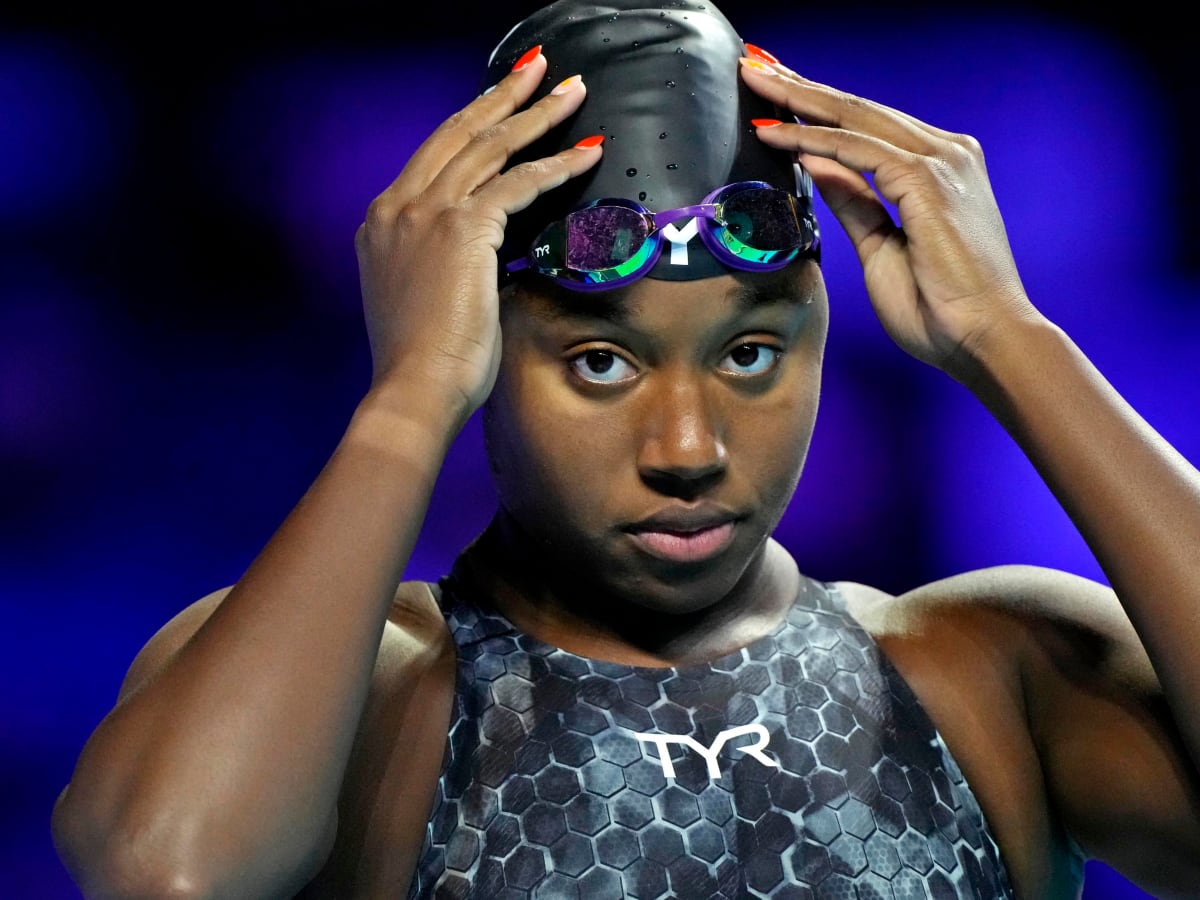
The recovery regimen:
She really focuses a lot on her recovery area. She makes sure that she would rest and recover before the next week of strenuous activities. She says, "I’m off on Sundays, so I usually get a massage. It loosens my muscles so I’m prepared for the next week of workouts. I have my own NormaTec machine, which I use about three times a week. My worst habit is checking social media right before I go to bed. I still need to work on my sleep hygiene."
What’s next:
Her goals are quite big and she doe not leave any stone unturned in achieving them. In her words, “My goal at the World Championships is to win a few medals both individually and in the relay. By the time I get to the Olympic Trials in June 2020 and hopefully to the Olympics in Tokyo, I want my races to be as perfect as possible.”

She opened up about months-long health challenges she dealt with while training during a press conference just three days before her victory. During March, she was diagnosed with overtraining syndrome and would have had to deal with frightening symptoms, which may have jeopardized her trip to Tokyo. "It was the biggest fight of my life," she said as she fought the emotional and physical battle.Manuel said that in January she started to feel unwell, and by March she was experiencing alarming symptoms and it was both inside and outside the pool. Upon receiving this diagnosis, she began to modify her training schedule under the guidance of her doctors, but her health continued to deteriorate. Swimming was not allowed for three weeks until mid-April, which would have prevented her from competing at the trials.Yet during the press conference, Manuel revealed that she had been diagnosed with overtraining syndrome earlier this year. Consequently, I did not swim in the pool for three weeks between March and April.After two weeks of swimming, Manuel was asked to take a three-week break by her coach, Greg Meehan, and her doctors. In addition to insomnia, depression, and sore muscles, Manuel complained of suffering from insomnia. Her experience was that every time she walked up to the pool to practice she would feel "gassed."At rest, her heart rate increased, she explained. She would try to perform basic exercises and would feel exhausted."During this process, I definitely was depressed," Simone Manuel said. "I isolated myself from my family. My mom would ask me questions on the phone and I would snap at her in ways I typically wouldn't. I had a hard time eating at times. I think the only way I got through it was talking to my loved ones and sports psychologist."
As for her three-week break, Manuel says she did not exercise, spending her time with her family, and taking a complete break. In less than two months, Manuel will compete in the United States after his first time in the pool since April 17. Trials for the Olympics."It was an uphill climb once I got back in the water," said Manuel. "Some days were good, some days weren't great. To sit here and even do what I did and be at this meet was something that I can't take lightly."

The fact that Manuel was able to compete at the US Olympic trials was a proud moment for her, given the events she had to endure in 2021. When she first started feeling symptoms of OTS, it was in January. She said most of the training was going well, but that she did have one or two bad practices. In March, there were more bad days than good, and she realized she needed assistance. In her statement, Manuel said that she sees a sports psychologist.In her words, swimming is one of the most recent activities that she enjoys. "Swimming is one of the hardest sports because you have to be in the water every day," she said. "There is no offseason. You're pushing your body to maximize your potential." There would hardly ever be a time when she would miss any practice and she is quite proud of that. She explains, "I am a hard worker. I don't like missing practice, so to navigate all of that while still thinking of trials is hard."“My body wasn’t doing what I knew it was capable of,” Manuel said. “I had moments where I didn’t even want to go to the pool because I knew it was going to be bad.” The first signs of trouble appeared in January, Manuel said. Her body crashed to the point that she experienced raised heart rates while resting, anxiety, depression, insomnia, aching muscles from simple activities like walking upstairs, and workouts that once were easy to accomplish becoming exceedingly difficult. Have you wondered what overtraining syndrome is and whether you should be worried about it? Keep reading.
What Is Overtraining Syndrome?
Overtraining is when someone can't adequately recover between training sessions due to training at excessively high levels of intensity. Most commonly these disorders affect athletes and those who are physically active - but anyone can suffer from them whether they're training for the Olympics, training for a marathon, or just sweating their way through stress caused by pandemics.Manuel reported a prolonged rise in heart rate at rest as her first symptom before suffering from other physical and emotional ailments including sore muscles, loss of appetite, insomnia, depression, anxiety, and irritability. "Just walking up the stairs to the pool I was gassed," she said. As well as an increase in resting blood pressure, excessive cortisol production, and weight loss are common signs of overtraining syndrome. As a result of the intense amount of exercise, your body produces too much cortisol, the stress hormone, weakening your muscles and increasing the risk of getting sick or injured.

Not only your physical health but your mental and emotional well-being can be affected, as well. "Overtraining syndrome can seriously affect your mental health. It can sap your motivation, make you short-tempered, hostile, cranky, sad, anxious, depressed, and a whole host of other not-so-fun mood changes," as Alena Luciani, M.S., C.S.C.S., a strength and conditioning specialist and founder of Training2xl previously explained to Shape. She said she didn't want to be there during training since she didn't feel like she was reaching her peak. It seems she was losing touch with her family members and would "snap" at them, an act she usually did not do.Summary: Undernourishing your body with adequate fuel, rest, and recovery will put you at risk of overtraining and serious injury.Swimming World's Workouts From the Past series offers a glimpse into some of the training sets Allison Beebe put together for Simone Manuel when she was coaching the First Colony Swim Team in Texas. Manuel won the gold medal in the 100 freestyle at the 2016 Olympic Games to qualify for the 2015 World Championships, coached by Beebe, who coached Team USA at the 2018 Junior Pan Pacifics.SwimWorld veteran writer Michael J. Stott shared the workouts below from Manuel's 2012-13 season when he was showing signs of becoming a standout performer. Observing the work that superstars completed during their early years is always fun, and that's what these training sets provide.

Although Simone Manuel does not have any particular workout schedule, here is what she would do generally in her routine:
General Weekly Schedule
Monday AM – 90 minutes – aerobic pulling and kickingMonday PM – 120 minutes in the water – generally free, IM or backstroke aerobic work; 40 minutes of drylandTuesday PM – 120 minutes in the water – stroke work (non-free). The beginning of the season is more aerobic work gradually shifting to race pace work as the season progresses. Manuel usually swims with the fly or back group, although occasionally goes to the breaststroke group; 30 minutes drylandWednesday PM – 120 minutes in the water – broken swims or repeats from the block; 20-minute classroom sessionThursday AM – 90 minutes – general recovery, skill work (usually back, breast, or fly)Thursday PM – 120 minutes in the water. No set pattern but generally recovery work. Manuel will redo something from earlier in the week if necessary; 30 minutes drylandFriday PM – 120 minutes in the water with emphasis on a kick.Saturday AM – 120 minutes in the water. The sprint group starts with aerobic base work in September and transitions to race-specific training as the season progresses; 30 minutes of dryland vary during the season.
Simone Manuel: Sample sets from the 2012-2013 season
September 17, 2012: Early season backstroke set; 12 x 200 back – 3 on 2:30, 1 on 2:10 holding kick countOctober 16, 2012: Two Rounds – 4 x 25 max effort kick on 35, 50 easy, 4 x 25 max effort pull on:35, 50 easy, 2 x 100 on 3:00 from a push beating 2nd 100 of 200 goal time. Manuel was 1:00.2, 1:00.3 fly on the first round and 51.4, 51.3 free on the second round.November 2, 2012 (Example of Friday Kick Day – SCY)
- 12 x 75 kick- different stroke by 4: 4 on 1:30, 1:25, 1:20. Last 15 yards of each 75 at race pace intensity
- 16 x 50 – odds kick with board and snorkel on 40, evens swim on:35 carry kick into swim
Three Rounds
- 2 x 400 kick on 6:00, 5:40, 5:20 by round (with board and snorkel) – negative split
- 2 x 100, 75, 50 all-out kick on 1:00 base per 50
- 2 x 50 from blocks swim of the stroke you kicked
- 1 x 50 easy swim on 2:00
May 11, 2013: Speed Group – LCMThree Rounds4 x 25 on :40odds – 15 FAST/10 techniqueevens – 10 technique/15 FAST:20 rest4 x 50 on :50, :55, 1:00 by round at 200 pace100 technique on 3:001 x 100 AFAP with fins, paddles, snorkel – beat the best time on 2:00100 technique on 3:00May 14, 2013: Speed Group LCM
- 1 x 50 sprint on 1:00
- 1 x 300 on 4:30 – 5 dolphin kicks and breathe every 3
- 2 x 50 sprint on 1:00
- 1 x 300 on 4:30 – 5 dolphin kicks and breathe every 3
- 3 x 50 sprint on 1:00
- 1 x 300 on 4:30 – 5 dolphin kicks and breathe every 3
- 3 x 50 sprint on 1:00
- 1 x 300 on 4:30 – 5 dolphin kicks and breathe every 3
- 2 x 50 sprint on 1:00
- 1 x 300 on 4:30 – 5 dolphin kicks and breathe every 3
- 1 x 50 sprint on 1:00

Speedskaters like Simone greatly benefit from dryland training to build strength and power. For the 50 and 100 freestyle, Sophie trains primarily in the gym to help her accelerate off the blocks and turn quickly, as well as maintain a high stroke rate. With plyometric push-ups, single-legged hops, and barbell work, she incorporates explosive movements. It may surprise some that Manuel was able to maintain her competitive edge by sitting still during the COVID-19 lockdown because her explosivity is one of her key ingredients. Where does it come from? She has been working on improving her mental game."I've been able to kind of get into meditating, which is something that I hadn't done in the past,” the 100m freestyle Olympic champion told ESPN. “I've been stretching 15 minutes every day, which is something that I never did. So I'm really just finding ways to better myself outside of the pool… when things hopefully get back to normal, I'll be ahead of the game.”In fact, she wouldn't even mind partnering up with someone who shares the same passion as her. She explains, "Katie Ledecky, a five-time Olympic champion and former Stanford teammate, practices in a private pool to maintain her touch in the water. I wouldn't mind training with him in the future!"
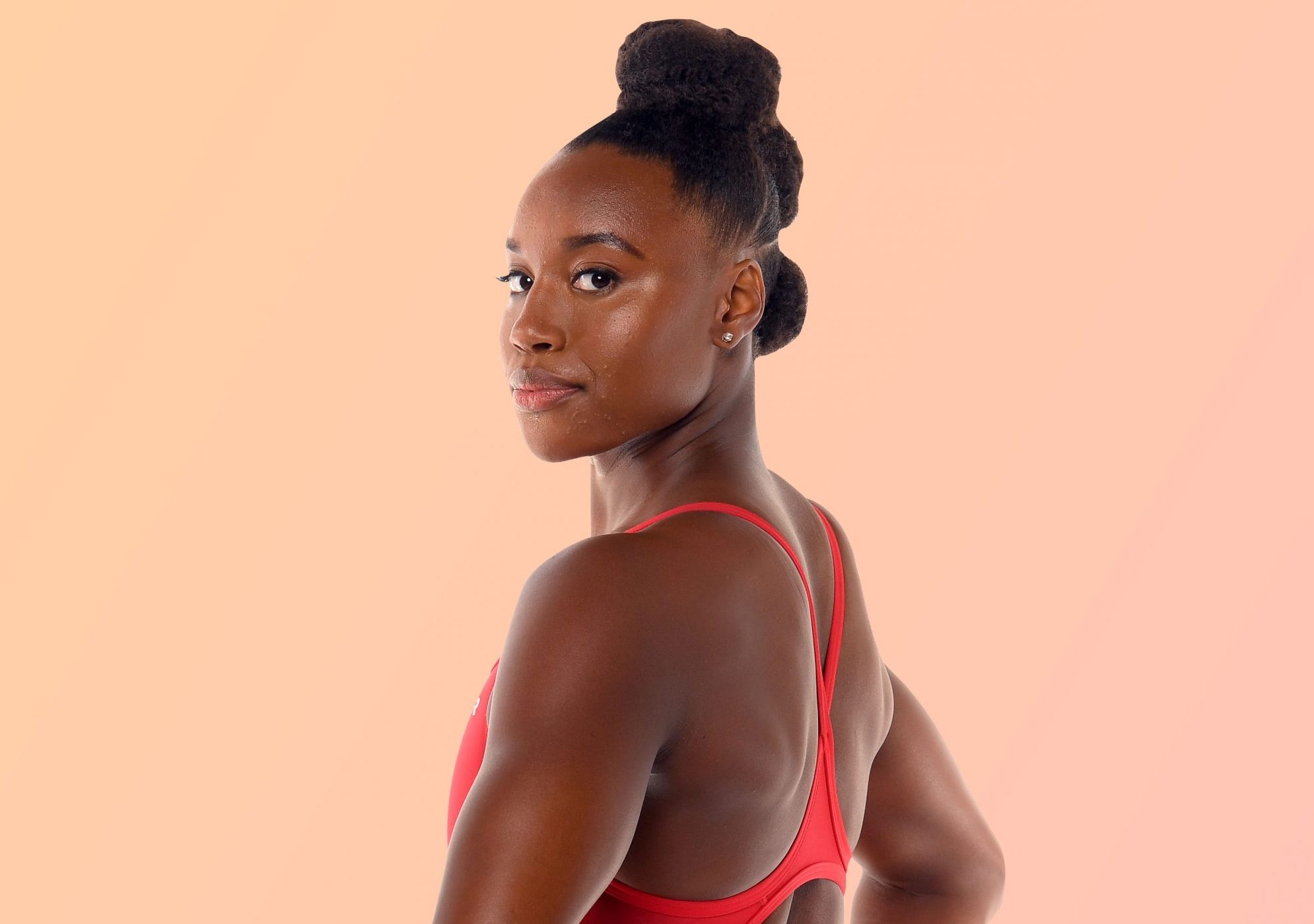
The workout routine Simone Manuel has to offer her fans was the subject of this article. She discusses how she strengthens and conditions all the different parts of her body to do well in the game. We can discuss more her fitness regimen in the next section, along with her diet plan.
Simone Manuel Diet Plan
With over-medium eggs and a dash of Tabasco, she usually has avocado toast for breakfast. You need to be on the edge. In addition to salads she enjoys eating, she includes bell peppers, pepperoncini, feta cheese, cucumbers, tomatoes, and kalamata olives in her dinners. Feta cheese is one of her favorite foods. Also, she can be found eating salmon with potatoes or chicken and rice. Definitely, a favorite is pesto pasta.One steak per week is a rule of thumb for her weight trainer, Cory Schlesinger, who believes that healthy fats, proteins, and iron improve performance. Since she became more regular about eating it, she has felt its benefits. She eats much the same way as when she is at home when she is traveling for competitions. Her favorite restaurant is an Italian one no matter where I am.She also eats smoothies on a regular basis. When she uses my frozen and refrigerated items, she usually uses mangoes, strawberries, raspberries, Greek yogurt, and orange juice. Before swimming, Bear Naked granola bars and Nature Valley bars are her favorite snacks. Her favorite foods are Greek yogurt and avocados or guacamole.
5:43 A.M.
5:40 in the morning is too early.to wake up and Five- forty-five in the morning is too late, therefore she set her alarm for 5:43 a.m. This gives her just enough time to leave the house by 5:50 a.m. So that She arrives on time for her 6:15 a.m. practice. As she doesn't drink coffee, she usually just grabs some water and either fruit snacks (Sunkist is my favorite) or granola bars like Nature Valley Oats 'n Honey while she's on her way.
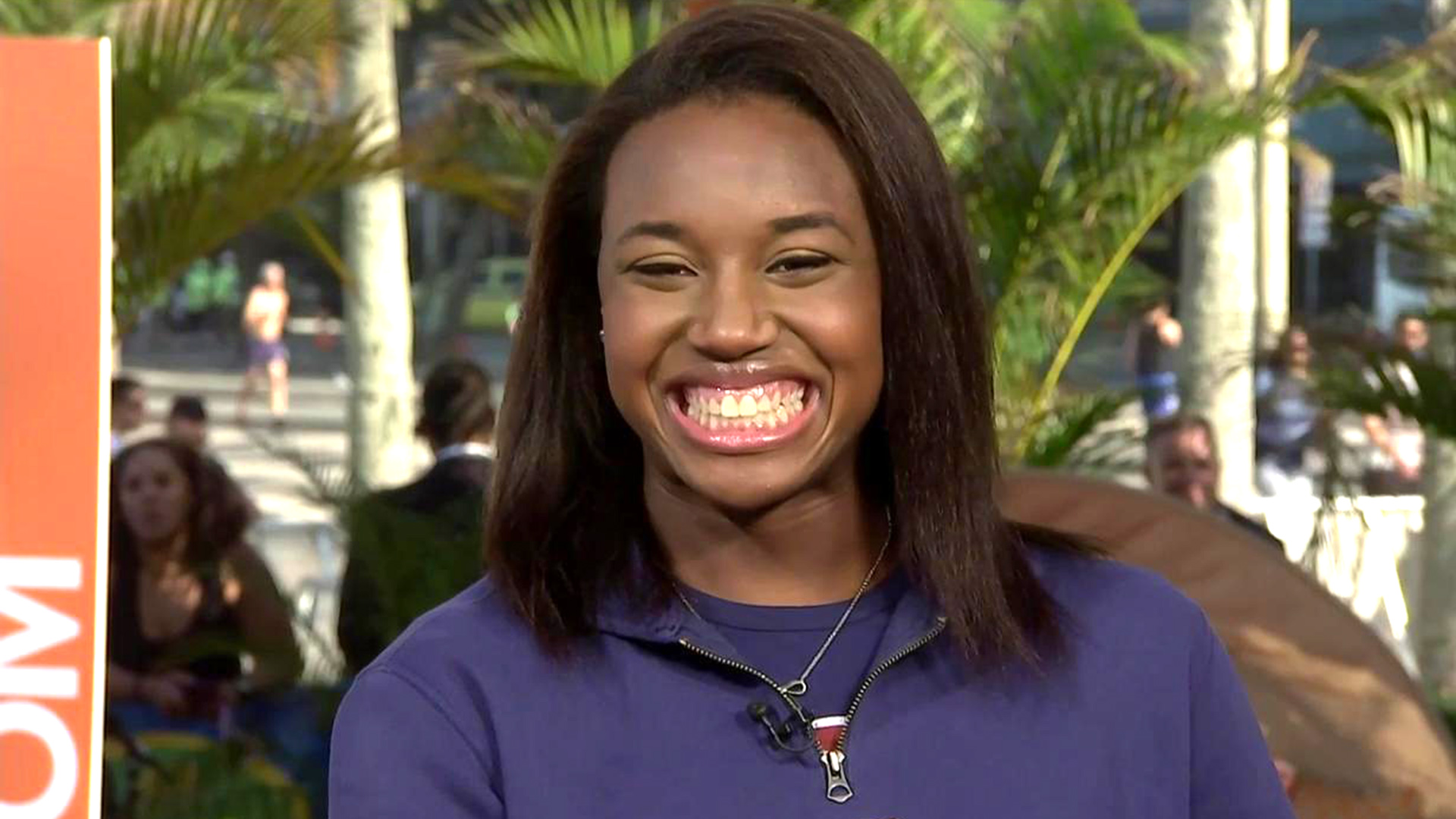
10:30 A.M.
As soon as she arrives at home after training, she'll eat avocado toast (on white bread) with cheddar cheese and three over-medium eggs. In order to spice things up, she likes to squeeze lemon juice and add Tabasco—she is a big fan of spicy foods. Water or orange juice is usually the only drink she drinks, but sometimes she will blend Greek yogurt, strawberries, blackberries, and blueberries into a smoothie.
1:30 P.M.
When She has the time, She'll make a Greek-style salad for lunch if She has the time. If she's busy, She'll just pick up some cashews or eat leftovers from last night. With Olive Garden's Italian dressing, she tosses romaine lettuce, cucumber, tomatoes, kalamata olives, pepperoncini, bell peppers, and feta cheese. After that, she will be back at training.
8 P.M.
She doesn't routinely count carbohydrates. Usually, when she cooks and eats, she just gets whatever she feels like. Food is her passion! One of the things She does is eat steak every week to get enough protein. However, seafood is her favorite thing to prepare. Salmon and potatoes are her favorite foods. With her potatoes, she cut them up really small, seasoned them with lots of salt, pepper, and red pepper flakes (salt, pepper, and red pepper flake), and roasted them in the oven.
9 P.M.
She sometimes enjoys dessert, but she is attempting to limit that. However, if She eats breakfast, she usually has a bagel with cream cheese or Frosted Flakes for breakfast. Her breakfast would be ready whenever she woke up!
Simone's Crab and Artichoke Cheese Dip... my latest obsession.
She also some of her favorite recipes which she has shared multiple times on her social media. Here is a recipe that she shared with her fans:Ingredients:⁃ 8 oz cream cheese (softened)⁃ 1/4 cup of sour cream⁃ 1/2 cup diced veggies, (I put mine in a food processor so they are pretty small and they release some water for the cheese mixture) I like mixed bell peppers/onions/1 ghost pepper (can use jalapeño or no spicy pepper at all), parsley, and 4-5 medium/small garlic cloves⁃ Pinches (not too small, not too big) of all these spices (season salt, paprika, cayenne pepper, black pepper)... but just season to liking.⁃ 4-5 canned artichokes - dice them (optional)- 1 lemon juiced⁃ 2 cans of your choice of crab meat (total of 1 pound of crab meat)⁃ 4 oz of Monterey Jack cheese⁃ 4 oz of pepper jack cheese⁃ Extra 2 oz of cheese for sprinkling on top

Directions:
- Preheat oven to 425 degrees and spray/oil pan
- Combine all ingredients except one crab meat can and cheese for the top in the mixer.
- Put half the mixture in the pan.
- Spread the crab meat from the second can evenly over the mixture.
- Layer the remaining half of the mixture on top of the crab (essentially, you are layering like a lasagna)
- Sprinkle the remaining 2 ounces (1 ounce of Monterey cheese and 1 ounce of Pepper Jack cheese) on top.
- To make it more visually appealing, sprinkle more paprika on top
- Depending on your oven, put the cakes in for 20-25 minutes.
- It must be bubbly for the dip to work!
- Then serve with crackers, crostini, tortilla chips, or charcuterie condiments of your choice.
- For a little extra kick, I love to serve this dip with sourdough crostini and some Calabrian chili!
.svg)



.svg)

